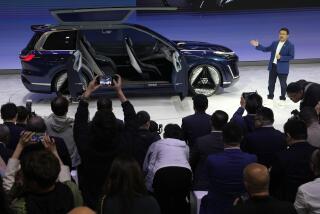Motorcycling in China takes unexpected turns
Imagine a place where motorcycles outnumber everything else on the road 5 to 1 - a place where the bikes are small, the tank badges are in Mandarin and the seats are covered in tapestries. That place is China’s Xinjiang province, where I spent eight days tooling around on two wheels. Here, from a rider’s perspective, is what it was like and what you need to know.
TRAFFIC
In Xinjiang’s cities, traffic moves slowly -- about 30 mph max -- which is good because it’s utter pandemonium, some of it motorized. It is made up of people, donkey carts, taxis, bicycles, scooters, motorcycles and motorcycles that have been converted into trucks hauling slaughtered animals, bags of rice, tree stumps, construction debris and just about anything else you can think of. On the highways, traffic was sparse, consisting mostly of soot-spewing semis that have been packed to the point of tipping over. Passenger cars were rare and tended to be Porsches and Land Rovers.
ROAD QUALITY
The best riding road was the Karakorum Highway between Kashgar and Tashkurgan, where the pavement was so smooth it seemed to have been poured yesterday. The military checkpoints and tanks on this two-lane freeway give it away: The Karakorum is the main military thoroughfare between China and Pakistan. The rest of the roads we traveled in this part of the country were worn but otherwise in good shape. Some were warped from heat, others pockmarked and washed out in places.
ROAD RULES
Rules? There aren’t many. Vehicles can ride on the sidewalk or either side of the street, and they do. There are, however, speed limits. Top speeds are supposed to be 100 km, or 62 mph, but half my tour group was German and accustomed to the autobahn, so we were frequent violators. Even so, we were pulled over for speeding only once. It’s amazing what a country’s history of corporal punishment will do. No sirens were involved. The police officer just stepped into the road, waved a white-gloved hand and our Chinese tour guide hit the brakes. After confiscating our Chinese driver’s licenses and calling us each by a Chinese name we didn’t know we had, the officer threatened to take our licenses away but let us go instead.
ROAD HAZARDS
The main hazards were packs of animals and stacks of rocks. In rural areas, you never knew when you would round a corner and need to slow for yaks or goats. You also never knew when your front end might slam into a stone. They don’t use orange traffic cones in this part of the world. When a vehicle breaks down, the driver alerts oncoming traffic with a pile of rocks stacked in the middle of the road.
GASOLINE
Customers don’t pump the gas. At some stations, the gas isn’t even pumped straight into the tank. It’s pumped into a teapot, then poured in. Use of cellphones and video cameras is banned at gas stations because they fear the electronics will ignite the gasoline. Like almost everything else in China, gas is relatively inexpensive, costing less than in the U.S. And there’s never a line at the pump because so few people drive in the remote and impoverished outskirts of Xinjiang province. The gas stations were mostly plentiful, enormous, empty and overstaffed with attendants in matching McDonald’s-like outfits.
MOTORCYCLES
The tour company arranges for the motorcycles, offers options for insurance and takes care of acquiring the Chinese driver’s license (but you must have an international license, available through the auto club). Most of the bikes are from an endless array of Chinese manufacturers, though there were also many Japanese models. All were small, usually about 125 cc. Many of the scooters were electric. Regardless of make or model, the saddles were tapestry -- woven kilims. Bikes tended to be ridden by at least two people and sometimes entire families.
PROTECTIVE GEAR
Most riders don’t wear protective gear. On the rare occasion a rider is wearing a helmet, it doesn’t have a strap, and it isn’t made for motorcycling. It’s more like a construction worker’s hard hat.
More to Read
Sign up for The Wild
We’ll help you find the best places to hike, bike and run, as well as the perfect silent spots for meditation and yoga.
You may occasionally receive promotional content from the Los Angeles Times.






